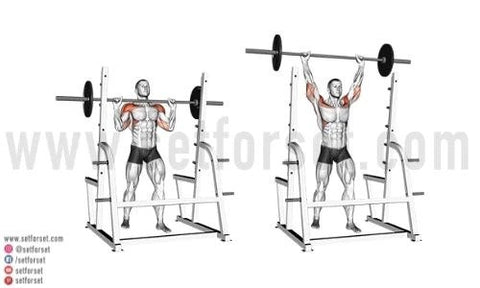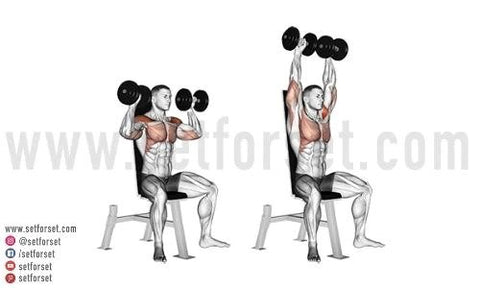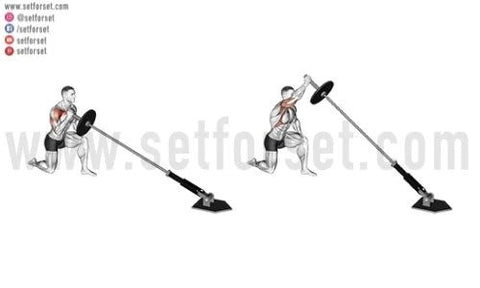When it comes to sculpting big, strong, and well-defined shoulders, there are a variety of exercises to choose from. One of the lesser-known movements is the Arnold Press. Named after the legendary Arnold Schwarzenegger, this exercise has a unique motion and style.
But how does it stack up against other popular shoulder exercises, like the shoulder press?
Take Your Fitness To The Next Level
In this article, we'll dive into the Arnold Press, dissect its benefits, and compare it to the overhead press, and several other press variations, to help you determine which one suits your goals best. Whether aiming for broader shoulders, improved shoulder strength, or enhanced shoulder stability, we'll guide you through the pros and cons of the Arnold Press and the shoulder press.
Table of Contents:
- What Is An Arnold Press?
- Arnold Press vs Shoulder Press: Key Differences
- How To Do An Arnold Press
- How To Shoulder Press
- Arnold Press vs Shoulder Press: A Side-By-Side View
- FAQs

What Is An Arnold Press?
The Arnold press is a shoulder press variation named after the famous bodybuilder, actor, and Governor of California, Arnold Schwarzenegger. Arnold popularized this movement during his bodybuilding career by making it a staple of his shoulder training.
It's a shoulder press variation where the dumbbells rotate with your palms facing you at the bottom of the movement before facing away from you at the top. Rotating the dumbbells provides a subtle but significant change in how the exercise feels. You can perform it seated or standing. Most of the time, Arnold preferred to do the exercise standing.
What is the Shoulder Press?
The shoulder is a classic upper-body strength exercise usually performed with dumbbells or a barbell. It involves lifting the weight straight up above your head, as seen with the overhead press, military press, and push press.
This exercise offers a range of advantages, such as improving strength, optimizing your body composition, and improving your functional movements.
Differences Between Arnold Press vs Shoulder Press
Although both the Arnold Press and the normal shoulder press have many similarities, there are some differences. When it comes to the Arnold press vs shoulder press, here's what varies.
1) Muscles worked:
The Arnold Press and the standard shoulder press both primarily target the deltoid muscles, working all three heads of the shoulder—front (anterior), middle (lateral), and rear (posterior). Both pressing variations also engage the triceps and upper chest to some extent.
The one difference comes in the degree of activation. A 2020 study showed Arnold Presses to be more effective for activating the anterior and medial deltoid muscles than the overhead dumbbell press1. With this in mind, the Arnold press might be better for building muscle.
2) Range Of Motion:
The Arnold Press incorporates a more extensive range of motion than a traditional shoulder press due to the rotational movement of the wrists during the exercise.
Rotating the wrists allows you to lower the dumbbells below your shoulders. The extended range at the bottom of the rep helps engage the shoulder muscles and rotator cuff muscles through different angles and planes of motion.
3) Loading:
Lifting heavier weights in the Arnold Press can be slightly more challenging due to the rotational component and the need for greater stability. However, this exercise can still be loaded with substantial weights for progressive overload.
In terms of implements, the Arnold press can be done with dumbbells or kettlebells. On the other hand, a traditional shoulder press can be done with dumbbells, kettlebells, barbells, landmines, or machines.
4) Training Goals:
The Arnold Press benefits those seeking a combination of shoulder strength, muscle size, and mobility. It's an excellent exercise for bodybuilders and individuals looking to add variety to their shoulder workouts. To up the ante for muscle activation, do Arnold Presses standing.
Research shows that standing dumbbell presses increase muscle activation more than seated2. The idea is the extra instability caused by standing activates the deltoids more, leading to better muscle growth.
If your goal is primarily strength, your best bet is an overhead barbell press, push press, or a dumbbell press from a seated position. All three movements allow you to lift a significant amount of weight.

How To Do An Arnold Press
You'll need a pair of dumbbells or kettlebells to perform an Arnold Press. Choose a weight that suits your strength level and goals. You can do the Arnold Press seated or standing - both variations are effective.
Arnold Press Form:
Here's how to properly perform the Arnold Press.

- Sit on the bench with your back supported and feet flat on the floor if seated. If standing, ensure your feet are shoulder-width apart for balance.
- Hold a dumbbell in each hand, just below your shoulders, with your palms facing your body. Your elbows should be bent. This is the starting position.
- Begin by lifting the dumbbells upward and away from your chest. As you lift, simultaneously rotate your wrists outward so that your palms face forward at the top of the movement. This rotation is a crucial feature of the Arnold Press.
- Continue raising the dumbbells until your arms are fully extended overhead. Your palms should be facing forward, and your arms should be almost straight but not locked out. This is the top of the movement.
- Reverse the motion by slowly lowering the dumbbells and rotating your wrists back to the palms-facing-inward position.
Arnold Press Benefits:
Looking for reasons why you should perform the Arnold Press exercise? Here are three great benefits.
- The Arnold Press effectively targets the shoulder muscles equally, or better than, all other dumbbell shoulder presses.
- It provides a larger range of motion, engaging the shoulders through different angles.
- The exercise is a unique variation that can be a nice change from typical shoulder press movements.
Arnold Press Drawbacks:
Every exercise has its downsides. Here's what to be aware of with the Arnold Press.
- It can be challenging to lift heavier weights due to the rotational component.
- Individuals with shoulder issues or limited mobility may experience pain in the shoulder joint doing the movement.
Programming Tips for Arnold Presses:
Start with lighter weights to perfect your form, and gradually increase the weight, following the method of progressive overload, as you become more comfortable with the exercise.
- Aim for 3-4 sets of 8-12 reps.
- Incorporate the Arnold Press into your shoulder workout routine once or twice weekly.
- Perform them toward the beginning of your workout.
How To Shoulder Press
When it comes to shoulder presses, you have many great options. I'm going to stick with the traditional overhead barbell press, a favorite among strength athletes, for this shoulder press vs Arnold press comparison.
Overhead Shoulder Press Form:
The overhead barbell press is one of the most popular shoulder-building exercises because it's simple and effective. It is a favorite among strength athletes because it allows you to handle heavy weights.
Here's the proper form for the Overhead Barbell Press.

- Stand in an athletic stance and grip a barbell with your hands around shoulder width.
- Lift the barbell off the rack and position it at shoulder height, resting on your front shoulders.
- Take a deep breath, engage your core, and brace your abs. From there, press the barbell overhead in a straight line. Extend your arms fully without locking your elbows.
- Lower the barbell under control back to the starting position.
Shoulder Press Benefits:
Here's a look at the best benefits of regular shoulder presses.
- The overhead press primarily targets the front and middle deltoid muscles, building shoulder strength and size.
- It engages the triceps, upper chest, and core for stability.
- The overhead press allows you to handle more weight than any other traditional shoulder exercise. Therefore, it's excellent at developing shoulder strength.
Shoulder Press Drawbacks:
The biggest downside to the shoulder press is that it can put significant stress on the shoulder joint and may not be suitable for individuals with preexisting shoulder issues.
Overhead Press Common Mistakes:
Perfect form is key to the overhead press. Here's what to avoid doing.
- Arching the lower back excessively.
- Allowing the barbell to drift too far forward or backward.
- Using too much weight, sacrificing range of motion.
Shoulder Press Programming Tips:
You can make the overhead press fit your goals, whether it's muscle hypertrophy or improving strength. Here's how to do it.
- You can wear a weightlifting belt to increase core stability.
- Perform 3-4 sets of 5-10 reps for strength and muscle-building.
- The overhead barbell press should be programmed first in your shoulder routine.
5 Additional Shoulder Press Variations
If you're looking for more great pressing variations, you've come to the right place! Here's a look at 5 other takes on the shoulder press. In addition to these, a great option for beginners is the machine overhead press, which is ideal for those who need more stability.
1. Barbell Push Press:

The barbell push press is an explosive compound exercise for strength and performance training. The exercise combines leg drive and upper body strength, making it an excellent exercise for overall power and shoulder development.
A few programming notes: The push press is one of the few exercises where it is okay to use momentum. Practice using your lower body to help drive the barbell overhead. Perform 3-4 sets of 3-6 reps for power and strength, performing it at the beginning of your workout.
How to do the Barbell Push Press:
- Begin in a standing position with the barbell racked at shoulder height.
- Grip the barbell just outside shoulder-width, with your feet hip-width apart.
- Dip at the knees, then explosively drive upward, using your legs to lift the weight overhead.
- Press the barbell fully overhead, then lower it back to your front shoulders.
2. Seated Dumbbell Shoulder Press:

The seated dumbbell shoulder press is a great movement because it offers stability, targets the shoulder muscles effectively, and can be adapted for a wide range of fitness levels. In addition, dumbbell shoulder presses isolate the shoulders and provide stability, allowing you to handle more weight, and it's great for those with lower back issues.
Programming notes: The seated dumbbell press is one of the best shoulder press variations for strength and size. This movement is an excellent alternative if you can't do a barbell overhead press. Perform 3-4 sets of 6 to 12 reps at the beginning of your shoulder workout.
If you're a fan of dumbbell shoulder workouts, this press variation is for you!
How to do the Seated Dumbbell Shoulder Press:
- Sit on a bench with back support, holding a dumbbell in each hand.
- Kick the dumbbells up to shoulder height from your knees and press them overhead until your arms are fully extended.
- Lower the dumbbells back to shoulder height once you reach the top of the movement.
3. Single Arm Dumbbell Press:

The single-arm dumbbell press is one of the most challenging shoulder press variations you can do. Using one dumbbell requires a lot of core stability to maintain good positioning, and it helps address muscle imbalances by working each arm independently. Plus, it enables your body to change the range of motion for the shoulders.
When programming this exercise, start light until you get the hang of it. In addition, perform 3-4 sets of 6-12 reps for muscle building, incorporating in the beginning or middle of your workout.
How to do the Single Arm Dumbbell Press:
- Sit on a bench with back support or stand with a dumbbell in one hand at shoulder height.
- Press the dumbbell up until your arm is fully extended.
- Lower the dumbbell back to the starting position.
4. Z Press:

The Z-Press is an excellent shoulder exercise as it challenges the shoulders and core while promoting proper posture, making it ideal for building strength and stability. Its minimal space requirements make it accessible to people training in their basements with low ceilings.
When programming the Z-Press, perform 3-4 sets of 6-10 reps for shoulder strength and stability, and incorporate these in the beginning or middle of your workout.
How to do the Z Press:
- Sit on the floor with your legs extended.
- Hold a barbell or dumbbell with both hands at shoulder height.
- Press the weight up until your arms are fully extended.
- Lower it back to the starting position.
5. Landmine Press:

I'm a huge fan of landmine exercises, and the landmine press is no exception. The landmine press is incredible because it offers a unique pressing motion that targets the shoulders and upper chest while reducing strain on the shoulder joints. Its movement pattern, versatility, and adaptability make it valuable to any strength training routine.
When programming the landmine press, keep in mind tou can do the landmine press from a standing or kneeling position. Kneeling shifts more focus toward the shoulders. Perform 3-4 sets of 8-12 reps for shoulder and upper chest development, placing these in the middle or end of your workout.
How to do the Landmine Press:
- Place one end of a barbell in a landmine attachment or securely in a corner.
- Hold the other end of the barbell with one or both hands near your shoulder. This is the starting position.
- Press the barbell upward until your arms are fully extended.
- Lower it back to your shoulder.
Arnold Presses vs Shoulder Presses: Which Is Best For You?
When it comes to the Arnold press vs shoulder press, which is best for you? Take a look at this side-by-side comparison to determine which will help you hit your goals.
|
Aspect |
Arnold Press |
Shoulder Press |
|
Definition |
Shoulder press variation |
Classic move |
|
Muscles Worked |
Primary: Delts (front, middle, rear) |
Primary: Delts (front, middle, rear) |
|
Range of Motion |
Wide range of motion |
Standard range of motion |
|
Loading |
Harder to lift heavy |
Good for heavy lifting |
|
Training Goals |
Build muscle |
Strength training |
|
Exercise Type |
Done seated or standing |
Done seated or standing |
|
Benefits |
Targets shoulders effectively |
Great for shoulder strength |
|
Drawbacks |
Rotation makes lifting heavy harder |
May stress the shoulder joint |
|
Programming Tips |
Begin with lighter weights |
3-4 sets |
FAQs
Here are some answers to common questions about the Arnold press vs shoulder press.
Is a barbell shoulder press better than a dumbbell shoulder press?
It depends on your goals and preferences. The barbell shoulder press allows for heavier weights and might be better for building overall shoulder strength. In contrast, a dumbbell shoulder press can provide more range of motion and stability challenges for muscle engagement.
Did Arnold invent the Arnold press?
Yes, Arnold Schwarzenegger invented the Arnold Press and popularized it during his bodybuilding career. For more details on his workout routine, check out our article detailing the Arnold Split.
Will overhead press build big shoulders?
All shoulder presses, including exercises like the Arnold and overhead barbell press, can help build big shoulders by targeting the deltoid muscles. That said, consistent training and progressive overload are essential for muscle growth.
Is it bad to do a heavy shoulder press?
It's okay to do heavy shoulder presses, but it's essential to use proper form to avoid injury. Start with weights you can control, gradually increase them as your strength improves, and always prioritize quality technique.
Why can't I lift heavy on shoulder press?
The inability to lift heavy on the shoulder press could be due to various factors, including lack of strength, improper form, or underlying shoulder issues. It's essential to assess your technique first. From there, you can gradually increase weights to build strength.
Related: How many shoulder exercises per week?

Arnold Press vs Shoulder Press: Which Is Better?
When deciding between the Arnold Press vs shoulder press, it depends on what you want to achieve with your workouts. The Arnold Press is a versatile tool. It works your shoulders differently and improves strength, size, and mobility. However, there might be better choices if you're mainly interested in lifting heavy weights for pure shoulder strength.
On the other hand, the shoulder press, especially with a barbell, is all about building serious shoulder strength and size. It's a great exercise for those who want to lift heavy and focus on performance. It has less fancy movement, but it's simple and effective.
So, which of the two exercises you pick is dependent on your goals. If you want well-rounded shoulders and want to try something different, go for the Arnold Press. If you want strong shoulders, choose the shoulder press.
In reality, many people find it helpful to do both. This way, you can get the best of both worlds. Just make sure you're doing the exercises correctly and safely. In the end, the best movement is the one that helps you meet your goals and works well for you.
Looking for more great shoulder exercises? Check out the 9 Best Barbell Shoulder Exercises, 16 Best Cable Shoulder Exercises, and 9 Bodyweight Shoulder Exercises.

Prepare to maximize your strength with our exclusive 13-week strength training program. 3, 4, and 5 day per week programming options.
References:
- Campos, Y. A. C., Vianna, J. M., Guimarães, M. P., Oliveira, J. L. D., Hernández-Mosqueira, C., da Silva, S. F., & Marchetti, P. H. (2020). Different Shoulder Exercises Affect the Activation of Deltoid Portions in Resistance-Trained Individuals. Journal of Human Kinetics, 75. https://doi.org/10.2478/hukin-2020-0033
- Saeterbakken, Atle H.1; Fimland, Marius S.2,3. Effects of Body Position and Loading Modality on Muscle Activity and Strength in Shoulder Presses. Journal of Strength and Conditioning Research 27(7). July 2013. | DOI: 10.1519/JSC.0b013e318276b873





0 comments